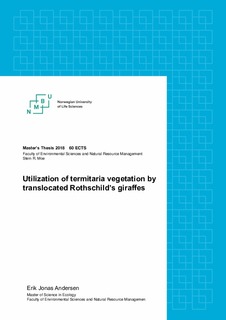| dc.description.abstract | Patches of high quality resources are important in many African savannahs. A source of this heterogeneity are mounds build by termites (termitaria). The soils and vegetation of termitaria have in many cases been found to be richer in important nutrients, and many studies have shown that termitaria are browsing hotspots for ungulates and megaherbivores. In 2015, 15 Rothchild’s giraffes (Giraffa camelopardalis rothschildi) were translocated to Lake Mburo National Park in Uganda. I conducted a study to explore to what extent giraffes utilize termitaria vegetation. The giraffe’s diet was observed in the dry season from June to August, as well as sampling the vegetation of the study area. Vegetation samples were taken along the feeding transect of the giraffes, perpendicular to the feeding transect, and randomly within the study area. The giraffe’s diet preference was analysed in relation to the vegetation available to the giraffes on and off termitaria. Giraffe’s were found to browse mainly on savannah vegetation consisting of Acacia gerrardii and other Acacia, and browsed on termitaria vegetation less than expected. The composition of species browsed on and off termitaria was found to be significantly different from eachother, with some overlap. Rhus natalensis and Carissa spinarum were browsed more than expected on termitaria, with R. natalensis being the most browsed species on termitaria, while C. spinarum had few browsing observations and bites associated with it. As the dry season progressed, the giraffes showed increased preference for termitaria vegetation in general, as well as R. natalensis. This study shows that for the giraffes of Lake Mburo National Park, while termitaria vegetation is utilized less than expected, it may be an important contributor to diet variability. | nb_NO |

